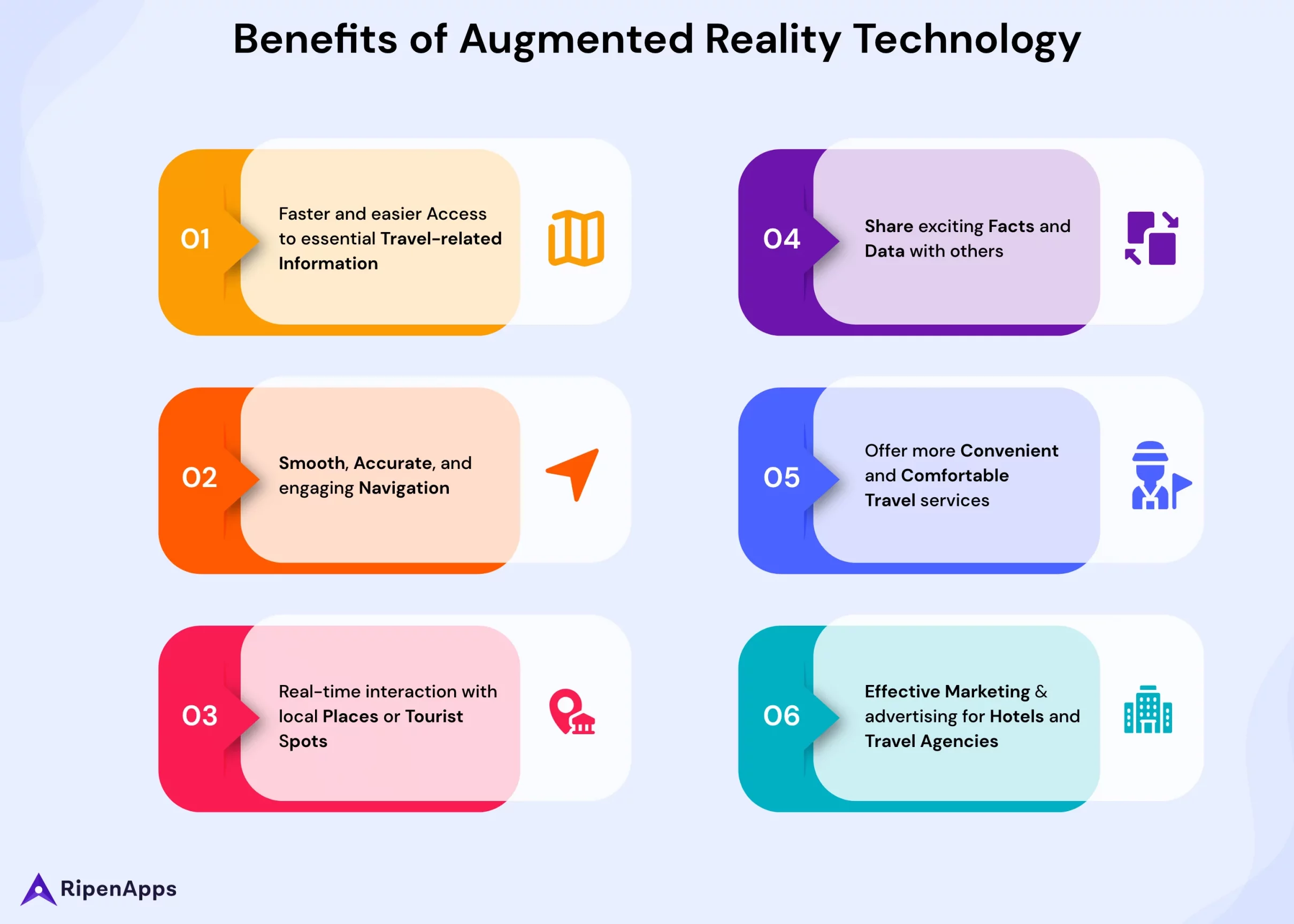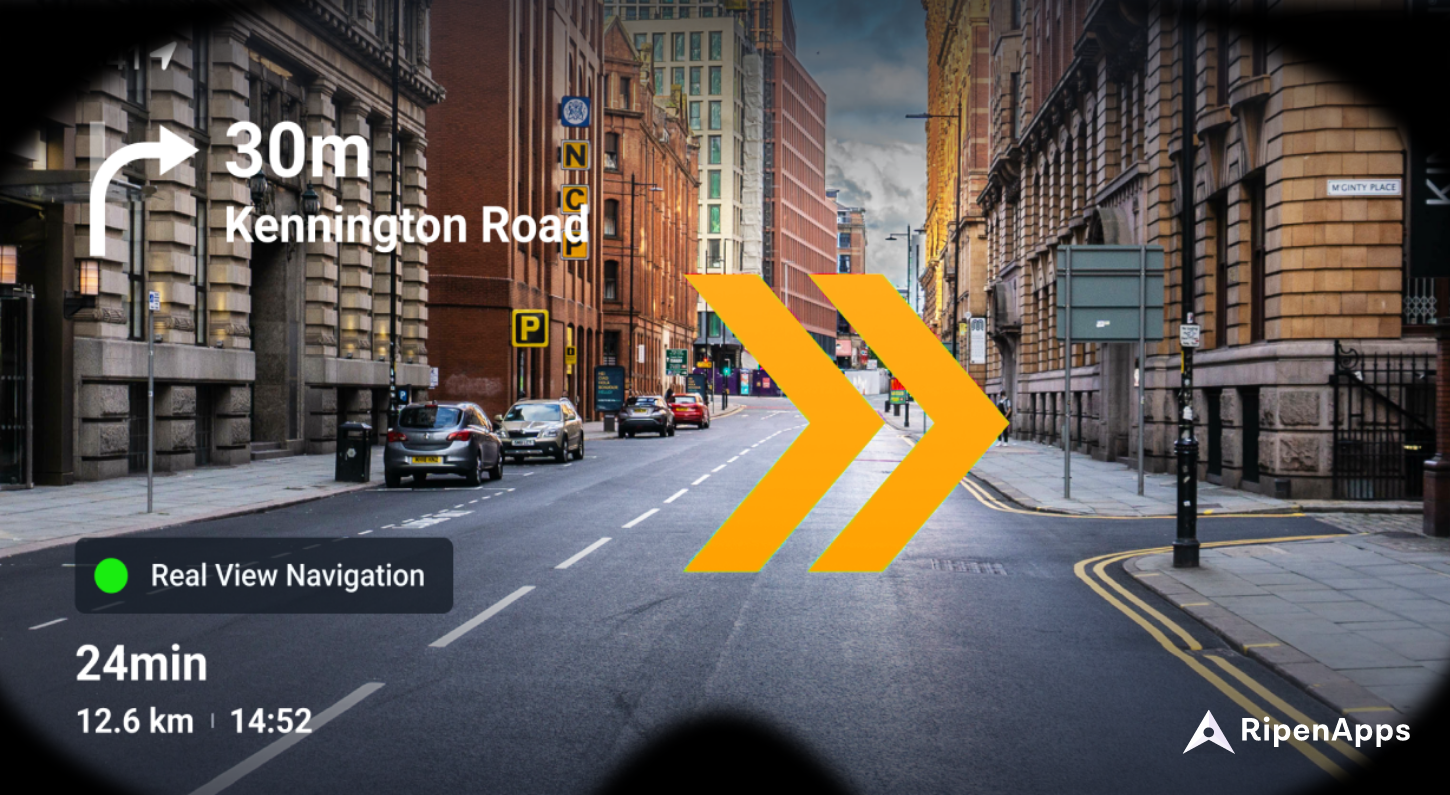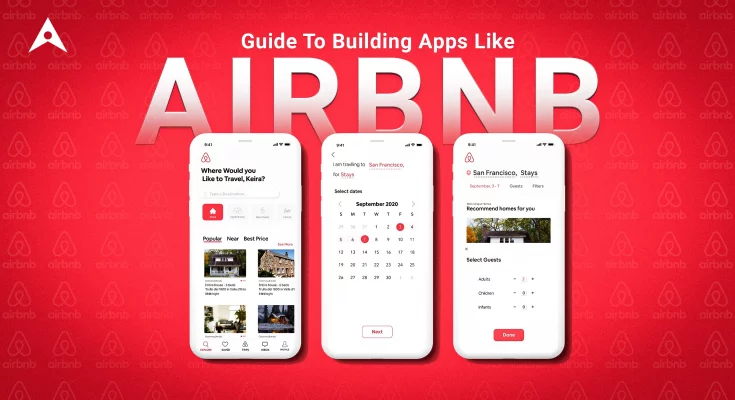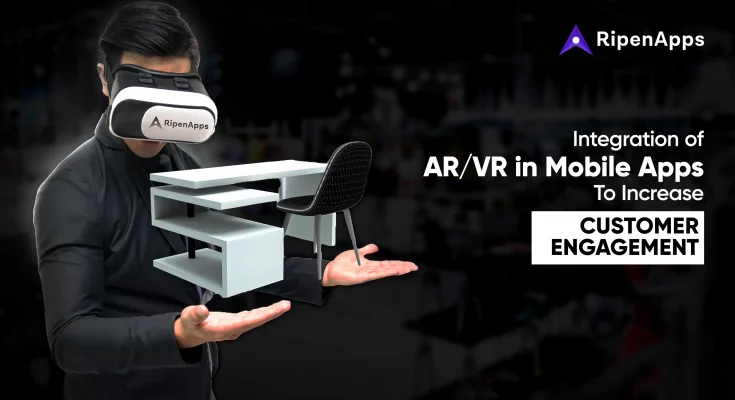How would you feel if you could travel to famous places and see their beauty while sitting in one place? It sounds fictional, but the use of Augmented Reality in the travel and tourism industry has made it a reality.
Businesses have already started using this emerging technology and have achieved success. In 2018, a Tokyo-based company, First Airlines, launched the world’s first virtual aviation facility. In this augmented and virtual reality airline, customers can book flights and wear AR headsets, dine on in-flight meals, and visualize global tourist spots.
The world’s leading travel accommodation company, Airbnb, recently integrated augmented reality into its application. The new AR feature lets customers explore properties virtually before booking and gives a fully immersive travel experience.
So, augmented reality isn’t only an emerging technology, it has become a necessary part of the industry. The use of AR in tourism has transformed the entire industry. The augmented reality in the travel and tourism market has grown tremendously. It will grow from $21.44 billion in 2024 to $109.13 billion in 2029. (Source: The Business Research Company)
These numbers highlight the growing usage of AR in AR technology in tourism. But, how does AR transform travel and tourism? In this blog, we will dive deep into the impact of this immersive technology in transforming the travel experience. So, let’s get started:
Table of Contents
What is Augmented Reality?
Augmented reality (AR) is an immersive technology that integrates virtual environments with real-world scenarios. It is an innovative technology concept that allows users to overlay real-world objects with 3D virtual graphics. Augmented reality aims to provide an immersive and interactive experience through digital elements, sounds, and other sensory stimuli. It gives the power to users to visualize in the real world which is not possible in reality by other means.
How Does Augmented Reality Work in Travel & Tourism?
Augmented reality in the tourism industry works in several transformative ways. It eliminates the barriers of time, money, and distance for people who are very passionate about exploring the world. AR works as a boon for those who are unable to travel to international destinations due to unavoidable circumstances.
One of the most crucial benefits of augmented reality in tourism and travel is allowing individuals to visit any place while sitting at one place.
In simple words, AR lets you take tours from home. In addition to this, augmented reality technology assists travel agencies and tourism businesses in enhancing their customer experience.
By using AR in travel applications or software they can improve their services. And thus, they achieve better revenue growth. So, augmented reality for the travel industry & tourism industry works in various ways, which-
1. Giving More Information About Places: By Integrating augmented reality into the travel app makes the application more powerful and feature-rich. The augmented travel app is able to give extra information while displaying things such as public transport, pharmacies, bus stops, etc.
2. Real-time Virtualization: Augmented reality enables the user to create a custom virtual environment. Users need to point out the smartphone’s camera where they are and get instant information or augmented scenes. The use of AI in travel contributes a lot to real-time virtualization.
3. Gamification: Pokémon Go is one of the greatest successful examples of gamification or augmented reality in travel industry. This gaming app utilized augmented reality with travel in gamification form. Hence, AR works as a gamification method in travel & tourism. This is a prime example of what is augmented reality used for in the travel industry.
Current Market State of Augmented Reality in the Tourism Sector
Augmented reality technology is dramatically transforming the travel & tourism sector. From providing an immersive experience to giving adequate information, Augmented reality travel is completely unmatched.
Even the best travel app development companies and tourism agencies have already started augmented reality tourism by implementing AR in their existing system and applications. Consequently, they have witnessed substantial growth with AR-powered travel solutions. And this growing adoption of augmented reality in tourism is opening more opportunities for travel businesses. If you look at the current market statistics of AR tourism,
- The revenue in the Augmented Reality (AR) and Virtual Reality (VR) market is expected to reach $46.6 billion in 2025. It is leading to a projected market volume of $62.0 billion by 2029.
- The AR/VR in the travel and tourism industry is projected to reach $109.13 billion in 2029, with a CAGR of 38.6%.
- Around 70% of consumers feel that augmented reality technology could overtake VR in the near future.
- AR software holds the largest market share in the entire AR/VR market with a projected market volume of $14 billion in 2025.
Hence, seeing the latest market statistics and trends, it is evident how tremendously augmented reality in the tourism sector is expanding. And this is because of the following benefits of AR technology. With this growth, both augmented reality and tourism are becoming more popular and reliable.
Benefits of Augmented Reality In Travel and Tourism
There are several benefits of augmented reality travel and tourism for businesses and users. This technology has unlocked a new path for the industry and helped businesses achieve success in the digital and competitive era. Here are the important benefits of augmented reality in tourism and travel:

- Faster and easier access to essential travel-related information
- Smooth, accurate, and engaging navigation
- Real-time interaction with local places or tourist spots
- Share exciting facts and data with others
- Offer more convenient and comfortable travel services
- Effective marketing & advertising for hotels and travel agencies
Popular Examples of Augmented Reality in Tourism & Travel
Augmented Reality (AR) is reshaping the travel experience by blending digital enhancements with the real world, providing tourists with immersive, informative, and interactive journeys. In the travel & tourism industry, some businesses use augmented reality for destinations, and we are going to discuss the augmented reality tourism examples:
- Google Maps Live View
- Yelp Monocle
- Airbnb’s AR
- National Geographic AR
- AR City
- Google Lens
- Citymapper
- The Gatwick Airport Passenger app
- Horizon Explorer
- Wikitude World Browser
- World Around Me
How is Augmented Reality Reshaping the Travel & Tourism Industry?
1. Augmented Travel Experience
One of the top ways AR technology is transforming the travel & tourism industry is by providing interactive and immersive tour experiences. The use of AR in travel and tourism allows users to get virtual or interactive tours of travel destinations or tourist spots. By using AR-based travel apps, users can go on virtual tours of famous landmarks while being in one place.
They can also use such apps to get extra information while traveling about ancient buildings, landmarks, and locations. AR also assists in location-based technology for mobile apps to give proper navigation and city tour guides. Hence, augmented reality in tourism acts as an amazing way of learning and exploring world places and getting interactive AR tour experiences.
2. AR-powered Self-Guided Tours
For tourists, traveling to new places without a local tour guide is extremely challenging. It is always not so easy to find a reliable guide who can help you nicely through the top places with a well-guided tour explanation. But with the advent of augmented reality in tourism, things are getting fully revolutionized. Augmented reality travel empowers travelers or tourists with self-guided tour ability.
They can use AR headsets or AR mobile apps for object recognition. And get full information about local places like museums, food joints, stations, historical landmarks, etc. This use of augmented reality in tourism has brought a disruptive change. Top mobile app development companies and tourism businesses are increasingly adopting AR technology in their solutions to build innovative travel solutions.
3. Travel From Home
Ever thought of visiting world-famous tourist destinations without leaving home? It might appear strange at first glance, but the use of augmented reality in tourism has broken the old traditions. Now, it is not mandatory to leave your home for traveling destinations. With AR-powered mobile apps, users can simply watch and virtually explore world-famous destinations or ancient places.
Not only this but by using AR glasses, people can get an immersive tour experience with various interactive elements. And thus enjoy engaging augmented travel experiences. It is AR in travel and tourism that has disrupted the concept of travel from home in the tourism industry. Therefore, due to its growing demand, businesses are highly interested in the inclusion of virtual reality in mobile apps to increase customer engagement.
4. Interactive Advertising and Marketing
The travel and hospitality industry highly relies on advertising and marketing. Hotels, accommodation facilities, and travel agencies need to promote their products and services effectively to increase sales and revenue. Augmented reality technology also helps hotels and other travel businesses improve their marketing. The use of augmented reality in hospitality industry allows businesses to provide augmented reality virtual tour guides of rooms, hotels, and accommodation facilities.
Many hotels are currently using AR to allow their users to take a 360-degree view of rooms before booking and give enhanced customer satisfaction. They also offer AR tour facilities through web or mobile apps to assist customers in decision-making. Hence, augmented reality & app development together are transforming the advertisement and marketing practices in the tourism sector. However, it can increase the travel app development cost for businesses.
5. AR-based Travel Mobile Apps
The travel and tourism industry has been using mobile apps for over a decade. From ticketing booking to hotel reservation and travel planning to buying travel packages. Mobile apps are being used in several ways to offer multiple travel services. However, due to increasing innovation and technological advancement, the travel industry needed innovative technology for bringing their digital offerings to the next level.
And AR technology here empowers the travel & tourism industry by developing innovative and feature-rich travel apps. Businesses hire dedicated mobile app developers to build next-gen travel mobile apps using AR that satisfy today’s user’s expectations and needs. Today, there are a variety of AR travel apps that allow users and businesses to take more advantage of their travel mobile apps. For instance
- Location-based AR app
- Marker-based AR application
- Marker-less applications
- SLAM (Simultaneous Localization and Mapping Software)
- AR City tour apps
Read Also: Building Augmented Reality (AR) Apps for Android: Tools and Frameworks
How Can AR Boost Travel and Tourism Revenue?
The use of augmented reality in travel and tourism is not just limited to benefits and examples, it also helps boost the revenue of the industry. An augmented reality travel app has some wonderful features to captivate visitors, streamline the travel experience, and improve visitor interactions. These tools drive engagement and boost revenue. Here’s how the use of augmented reality in travel increases revenue:
1. Improved Virtual Tours
The use of AR in travel and tourism allows users to explore destinations virtually, navigate attractions, and interact with virtual elements. Augmented reality unlocks opportunities to generate revenue through the augmented reality virtual tour, ticket sales, and partnerships with local businesses.
2. Virtual Shopping Experiences
Virtual shopping experiences are one of the top augmented reality in tourism examples. With the use of augmented reality in travel industry, tourists can virtually try on clothing, accessories, or test products before purchasing them. This usage of augmented and virtual reality in tourism enhances the shopping experiences and provides a unique way for travel companies to earn more money. Partnering with local retailers can allow businesses to offer exclusive discounts and promotions. To build such an app, you need to partner with an experienced augmented reality app development company.
3. Gamification in Travel & Tourism
Businesses can introduce game-like features, allowing users to participate in interactive challenges, complete quests, and earn rewards. After applying this concept, the use of augmented reality in travel can make the industry engaging and educational. It allows travel companies to generate additional revenue. To earn more money, businesses can provide premium game experiences, extra features, or in-game purchases and upgrades. To use gamification in this industry, you can go through the travel app development guide.
The Bottom Line
Augmented reality is an innovative technology. It provides many benefits to the travel & tourism industry. With AR, travelers can see a deeper vision of places and enjoy a never-feel-like travel experience. It helps travel businesses and other subsidiaries to upgrade their existing services and achieve better outcomes and sales growth.
Therefore, augmented reality in the tourism industry is emerging as the hottest trend and opening wider scope for the future. And this AR penetration in the travel sector has broadened the business scope for startups and new business ventures. They can come up with custom or innovative travel solutions using AR technology.
But developing smart AR-based travel solutions requires an intelligent approach and the right use of technology. hence, it is advisable to take assistance from the best mobile app development company that holds specialization in building AR-based travel solutions. And RippenApps is one such reliable company that can assist you turn your innovative AR travel app concept into a feature-loaded application.
FAQs
Q1. How much does it cost to build AR travel mobile app?
Developing an AR-based travel mobile application requires dedicated AR tech stacks and other supportive technology to build essential augmented reality features. So, the final cost of AR app development depends on multiple factors. We advise you to consult a professional mobile app development company and get a price quotation as per your project requirements.
Q2. What are the popular examples of augmented reality in tourism?
There are many examples that demonstrate the effective use of augmented reality for travel and tourism purposes. Some of the popular examples are Google Maps Live View, Airbnb’s AR Try Before You Book, National Geographic AR, AR City, etc.
Q3. How is augmented reality used in travel?
Augmented reality in tourism and travel improves experiences by overlaying digital content on real-world locations. Travelers can access interactive maps, landmark info, virtual tours, and translation through AR applications.
Q4. How does AR improve sightseeing experiences?
Augmented reality sightseeing allows travelers to point their phones at landmarks to see historical facts, visual overlays, or even animations of how structures looked in the past. AR makes sightseeing more interactive and educational.
Q5. Is AR being used in hotels or hospitality?
Using augmented reality for hotels or hospitality is becoming a new normal and many hotels are using it for virtual room tours, interactive brochures, and even in-room experiences. It improves guest engagement and helps travelers make informed decisions.
Q6. What are the benefits of AR in travel and tourism?
Augmented Reality (AR) improves travel experiences by providing immersive, real-time information about destinations. This technology improves sightseeing with interactive guides, simplifies navigation, boosts customer engagement, and helps tourists explore cultures in engaging ways.













 India
India USA
USA Australia
Australia Canada
Canada UK
UK UAE
UAE
